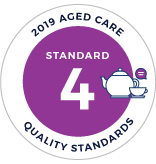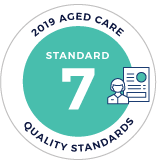DTA currently uses different terms for behaviour. We will be progressively moving to the term Changed Behaviour in all our content.
Aged Care Quality Standards
Australia’s new aged care quality standards represent a clear shift towards the rights of older Australians living in residential care.
At DTA, we offer a range of dementia courses, resources and services to help aged care providers meet the new standards, and prepare for assessment against them.

Review the eight new standards and learn how DTA can help your organisation
Standard 1
Consumer dignity and choice
Consumer outcome:
I am treated with dignity and respect, and can maintain my identity. I can make informed choices about my care and services, and live the life I choose.
Organisation Statement + Requirements +
Organisation Statement
The organisation:- has a culture of inclusion and respect for consumers; and
- supports consumers to exercise choice and independence; and
- respects consumers’ privacy
Requirements
The organisation demonstrates the following:- Each consumer is treated with dignity and respect, with their identity, culture and diversity valued.
- Care and services are culturally safe.
- Each consumer is supported to exercise choice and independence, including to:
- make decisions about their own care and the way care and services are delivered; and
- make decisions about when family, friends, carers or others should be involved in their care; and
- communicate their decisions; and
- make connections with others and maintain relationships of choice, including intimate relationships.
- Each consumer is supported to take risks to enable them to live the best life they can.
- Information provided to each consumer is current, accurate and timely, and communicated in a way that is clear, easy to understand and enables them to exercise choice.
- Each consumer’s privacy is respected and personal information kept confidential.

How DTA can help
Salutogenic Environments
 Our award-winning Dementia-friendly environments service can help you create a dementia-friendly environment that is enjoyable and meaningful, taking into account a person’s lifestyle, background and interests, as well as being familiar and recognisable.
Our award-winning Dementia-friendly environments service can help you create a dementia-friendly environment that is enjoyable and meaningful, taking into account a person’s lifestyle, background and interests, as well as being familiar and recognisable.
Online dementia courses
![]() Our online courses cover topics ranging from caring at night for people with dementia, to caring for LGBTI people with dementia. All courses start with a brief overview of our ‘salutogenic’ approach which is about finding opportunities for people with dementia to live the fullest life they can.
Our online courses cover topics ranging from caring at night for people with dementia, to caring for LGBTI people with dementia. All courses start with a brief overview of our ‘salutogenic’ approach which is about finding opportunities for people with dementia to live the fullest life they can.
Tailored Training Programs
 Our Tailored Training Programs are designed to bring about sustainable change within organisations to improve the wellbeing of people living with dementia and the staff who care for them.
Our Tailored Training Programs are designed to bring about sustainable change within organisations to improve the wellbeing of people living with dementia and the staff who care for them.
Standard 2
Ongoing assessment and planning with consumers
Consumer outcome:
I am a partner in ongoing assessment and planning that helps me get the care and services I need for my health and well-being.
Organisation Statement + Requirements +
Organisation Statement
The organisation undertakes initial and ongoing assessment and planning for care and services in partnership with the consumer. Assessment and planning has a focus on optimising health and well-being in accordance with the consumer’s needs, goals and preferences.Requirements
The organisation demonstrates the following:- Assessment and planning, including consideration of risks to the consumer’s health and well-being, informs the delivery of safe and effective care and services.
- Assessment and planning identifies and addresses the consumer’s current needs, goals and preferences, including advance care planning and end of life planning if the consumer wishes.
- Assessment and planning:
- is based on ongoing partnership with the consumer and others that the consumer wishes to involve in assessment, planning and review of the consumer’s care and services; and
- includes other organisations, and individuals and providers of other care and services, that are involved in the care of the consumer.
- The outcomes of assessment and planning are effectively communicated to the consumer and documented in a care and services plan that is readily available to the consumer, and where care and services are provided.
- Care and services are reviewed regularly for effectiveness, and when circumstances change or when incidents impact on the needs, goals or preferences of the consumer.

Standard 3
Personal care and clinical care
Consumer outcome:
I get personal care, clinical care, or both personal care and clinical care, that is safe and right for me.
Organisation Statement + Requirements +
Organisation Statement
The organisation delivers safe and effective personal care, clinical care, or both personal care and clinical care, in accordance with the consumer’s needs, goals and preferences to optimise health and well-being.Requirements
The organisation demonstrates the following: The organisation demonstrates the following:- Each consumer gets safe and effective personal care, clinical care, or both personal care and clinical care, that: i) is best practice; and ii) tailored to their needs; and iii) optimises their health and well-being.
- Effective management of high-impact or high-prevalence risks associated with the care of each consumer.
- The needs, goals and preferences of consumers nearing the end of life are recognised and addressed, their comfort maximised and their dignity preserved.
- Deterioration or change of a consumer’s mental health, cognitive or physical function, capacity or condition is recognised and responded to in a timely manner.
- Information about the consumer’s condition, needs and preferences is documented and communicated within the organisation, and with others where responsibility for care is shared.
- Timely and appropriate referrals to individuals, other organisations and providers of other care and services.
- Minimisation of infection-related risks through implementing: i) standard and transmission-based precautions to prevent and control infection; and ii) practices to promote appropriate antibiotic prescribing and use to support optimal care and reduce the risk of increasing resistance to antibiotics.
- New standards – An opportunity to improve medication use in residential aged care
- Leading the change in medication management
- Change is here – amended legislation on chemical restraints in Australia

How DTA can help
Medication management
The  Medication Management Consultancy helps aged care providers ensure their use of antipsychotic medications is aligned with recommended practice. Available as part of a DTA Tailored Training Program.
Medication Management Consultancy helps aged care providers ensure their use of antipsychotic medications is aligned with recommended practice. Available as part of a DTA Tailored Training Program.
 Our one-hour online course covers best practice for antipsychotic medication management of responsive behaviours.
Our one-hour online course covers best practice for antipsychotic medication management of responsive behaviours.
![]() The Antipsychotic Tracking Tool helps aged care providers track use of antipsychotic medications at their organisation.
The Antipsychotic Tracking Tool helps aged care providers track use of antipsychotic medications at their organisation.
Responsive Behaviours
The  Responsive Behaviours Consultancy helps aged care providers build sustainable workforce capacity to identify, assess and address dementia-related responsive behaviours. Available as part of a DTA Tailored Training Program.
Responsive Behaviours Consultancy helps aged care providers build sustainable workforce capacity to identify, assess and address dementia-related responsive behaviours. Available as part of a DTA Tailored Training Program.
 Our Responsive Behaviours App is designed to help aged care workers respond to responsive behaviours.
Our Responsive Behaviours App is designed to help aged care workers respond to responsive behaviours.
 Our four-hour online course is designed to help you better understand how to care for a person experiencing dementia-related responsive behaviours.
Our four-hour online course is designed to help you better understand how to care for a person experiencing dementia-related responsive behaviours.
Pain management
 Our two-hour online course will help increase your understanding of pain assessment and management for people living with dementia.
Our two-hour online course will help increase your understanding of pain assessment and management for people living with dementia.
Standard 4
Services and supports
for daily living*
Consumer outcome:
I get personal care, clinical care, or both personal care and clinical care, that is safe and right for me.
Organisation Statement + Requirements +
Organisation Statement
The organisation delivers safe and effective personal care, clinical care, or both personal care and clinical care, in accordance with the consumer’s needs, goals and preferences to optimise health and well-being.Requirements
The organisation demonstrates the following: The organisation demonstrates the following:- Each consumer gets safe and effective services and supports for daily living that meet the consumer’s needs, goals and preferences and optimise their independence, health, well-being and quality of life.
- Services and supports for daily living promote each consumer’s emotional, spiritual and psychological well-being.
- Services and supports for daily living assist each consumer to:
- participate in their community within and outside the organisation’s service environment; and
- have social and personal relationships; and
- do the things of interest to them;
- Information about the consumer’s condition, needs and preferences is communicated within the organisation, and with others where responsibility for care is shared.
- Timely and appropriate referrals to individuals, other organisations and providers of other care and services;
- Where meals are provided, they are varied and of suitable quality and quantity.
- Where equipment is provided, it is safe, suitable, clean and well maintained.
*Services and supports for daily living include, but are not limited to, food services, domestic assistance, home maintenance, transport and recreational and social activities.

Tailored Training Programs (TTPs)
 TTPs give your organisation exclusive access to our data collection and evaluation service. This may include the opportunity for your organisations to directly engage with family carers/people with dementia in feedback about quality of care pre/post training.
TTPs give your organisation exclusive access to our data collection and evaluation service. This may include the opportunity for your organisations to directly engage with family carers/people with dementia in feedback about quality of care pre/post training.

Standard 5
Organisation’s service environment*
Consumer outcome:
I feel I belong and I am safe and comfortable in the organisation’s service environment.
Organisation Statement + Requirements +
Organisation Statement
The organisation provides a safe and comfortable service environment that promotes the consumer’s independence, function and enjoyment.Requirements
The organisation demonstrates the following: The organisation demonstrates the following:- The service environment is welcoming and easy to understand, and optimises each consumer’s sense of belonging, independence, interaction and function.
- The service environment: i) is safe, clean, well maintained and comfortable; and ii) enables consumers to move freely, both indoors and outdoors.
- Furniture, fittings and equipment are safe, clean, well maintained and suitable for the consumer.
*An organisation’s service environment means the physical environment through which care and services are delivered, but does not include an individual’s privately owned or occupied home at which in home services are provided.

How DTA can help
Dementia-friendly environments
 Our award winning Dementia-friendly environments service can help you create a dementia friendly environment that is is enjoyable and meaningful, taking into account a person’s lifestyle, background and interests, as well as being familiar and recognisable.
Our award winning Dementia-friendly environments service can help you create a dementia friendly environment that is is enjoyable and meaningful, taking into account a person’s lifestyle, background and interests, as well as being familiar and recognisable.
 Our Environmental Design Resources Handbook is a comprehensive guide to creating a dementia-friendly environment.
Our Environmental Design Resources Handbook is a comprehensive guide to creating a dementia-friendly environment.
 Our free BEAT-D App will guide you through the strengths and weaknesses of a building for people living with dementia.
Our free BEAT-D App will guide you through the strengths and weaknesses of a building for people living with dementia.
Did you know…
DTA’s Environmental Design Resource Handbook is the #1 recommended resource for Standard 5 of the Aged Care Quality Standards.

Standard 6
Feedback and complaints
Consumer outcome:
I feel safe and am encouraged and supported to give feedback and make complaints. I am engaged in processes to address my feedback and complaints, and appropriate action is taken.
Organisation Statement + Requirements +
Organisation Statement
The organisation regularly seeks input and feedback from consumers, carers, the workforce and others and uses the input and feedback to inform continuous improvements for individual consumers and the whole organisation.Requirements
The organisation demonstrates the following:- Consumers, their family, friends, carers and others are encouraged and supported to provide feedback and make complaints.
- Consumers are made aware of and have access to advocates, language services and other methods for raising and resolving complaints.
- Appropriate action is taken in response to complaints and an open disclosure process is used when things go wrong.
- Feedback and complaints are reviewed and used to improve the quality of care and services.

How DTA can help
Tailored Training Programs (TTPs)
 TTPs give your organisation exclusive access to our data collection and evaluation service. This may include the opportunity for your organisations to directly engage with family carers/people with dementia in feedback about quality of care pre/post training.
TTPs give your organisation exclusive access to our data collection and evaluation service. This may include the opportunity for your organisations to directly engage with family carers/people with dementia in feedback about quality of care pre/post training.
Standard 7
Human Resources
Consumer outcome:
I get quality care and services when I need them from people who are knowledgeable, capable and caring.
Organisation Statement + Requirements +
Organisation Statement
The organisation has a workforce that is sufficient, and is skilled and qualified to provide safe, respectful and quality care and services.Requirements
The organisation demonstrates the following: The organisation demonstrates the following:- The workforce is planned to enable, and the number and mix of members of the workforce deployed enables, the delivery and management of safe and quality care and services.
- Workforce interactions with consumers are kind, caring and respectful of each consumer’s identity, culture and diversity.
- The workforce is competent and members of the workforce have the qualifications and knowledge to effectively perform their roles.
- The workforce is recruited, trained, equipped and supported to deliver the outcomes required by these standards.
- Regular assessment, monitoring and review of the performance of each member of the workforce.

How DTA can help
Vocational Training
 Dementia Essentials is a face-to-face, nationally accredited course for workers who support people living with dementia. For more information, including how to book a course for your workplace, visit Dementia Essentials.
Dementia Essentials is a face-to-face, nationally accredited course for workers who support people living with dementia. For more information, including how to book a course for your workplace, visit Dementia Essentials.
Fellowships
 We offer coaching partnerships to selected organisations as part of a DTA Tailored Training Program, working closely with workplace leaders and change agents to create sustainable practice change within organisations.
We offer coaching partnerships to selected organisations as part of a DTA Tailored Training Program, working closely with workplace leaders and change agents to create sustainable practice change within organisations.
Standard 8
Organisational governance
Consumer outcome:
I am confident the organisation is well run. I can partner in improving the delivery of care and services.
Organisation Statement + Requirements +
Organisation Statement
The organisations’ governing body is accountable for the delivery of safe and quality care and services.Requirements
The organisation demonstrates the following:
- Consumers are engaged in the development, delivery and evaluation of care and services and are supported in that engagement.
- The organisation’s governing body promotes a culture of safe, inclusive and quality care and services and is accountable for their delivery.
- Effective organisation wide governance systems relating to the following:
- information management
- continuous improvement
- financial governance
- workforce governance, including the assignment of clear responsibilities and accountabilities
- regulatory compliance
- feedback and complaints.
- Effective risk management systems and practices, including but not limited to the following:
- managing high-impact or high-prevalence risks associated with the care of consumers
- identifying and responding to abuse and neglect of consumers
- supporting consumers to live the best life they can.
- Where clinical care is provided – a clinical governance framework, including but not limited to the following:
- antimicrobial stewardship
- minimising the use of restraint
- open disclosure

Preparing for assessment
against the new Aged Care Quality Standards
The new Aged Care Quality Standards aim to empower senior Australians and ensure responsibility and accountability for their care.
Watch as Sue Gordon, Education Coordinator at Aged Care Quality and Safety Commission, delves into the structure, intent and application of the new standards and advises on how best to prepare for assessment against them.
Keep up to date and subscribe
Enter your details below to start receiving the latest developments from DTA


